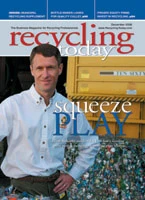MIND YOUR PSAs
The Curbside Value Partnership (CVP) has launched a new radio public service announcement (PSA) putting non-recyclers on notice.
The PSA, which is available in English and Spanish, features two housewives gossiping about their new non-recycling neighbor. The housewives decide that the new resident needs to know that her new neighborhood is "desperate about recycling." Listeners are then directed to www.recyclecurbside.org to learn about local recycling options.
"We wanted to break through the clutter and take a slightly humorous ‘Desperate Housewives’ approach to convey how ‘un-neighborly’ it is not to recycle," Heather McNamara, senior vice president of Hill & Knowlton, says. The CVP retained Hill & Knowlton to work with municipalities nationwide to grow participation in local programs.
CVP is a national partnership funded by the aluminum industry and its member companies, Alcoa, Anheuser-Busch Metal Container, ARCO, Ball, Novelis and REXAM. CVP has studied curbside recycling programs nationwide for three years in an attempt to learn how to motivate consumers to recycle curbside.
The CVP will distribute the PSA to more than 250 U.S. radio stations. Additionally, a partnership with Earth 911 will make the PSA available for free to local recycling coordinators and other interested parties upon request. Those interested in using the PSA should visit www.recyclecurbside.org to request a personalized copy of the PSA.
CVP partner communities include Kansas City, Mo.; Brevard County, Fla.; Indian River, Fla.; Denver; Orlando, Fla.; and Dallas.
CHICAGO TO TRASH BLUE BAGS
In comments made to the Chicago Tribune, Chicago Mayor Richard Daley has indicated that the city’s Blue Bag program will be replaced by a collection program that commingles recyclables in 96-gallon plastic carts.
According to the Tribune report, "a pilot program featuring blue [collection] carts for recyclables will eventually be expanded citywide."
The city recently announced that the pilot, which began in the Beverly ward on city’s south side in 2005, would be expanded to seven more wards by 2007.
The Blue Bag program, which has been in place since 1995, has been criticized for yielding low participation and recycling rates. A study conducted by the city in 2003 determined a 13.3 participation rate. However, Chicago officials report an 80 percent participation rate and a 23 percent diversion rate for the pilot program.
Although the Daley has long expressed confidence in the Blue Bag program, he reportedly indicated to the Tribune that the plastic collection carts will eventually be distributed to households throughout the city’s 50 wards. Recyclables will be collected twice per month under the new program instead of weekly.
U.S. RECYCLING RATE REACHES 32 PERCENT
America’s recycling rate saw a slight gain in 2005, moving from 31.4 percent in 2004 to 32.1 percent, according to statistics from the U.S. Environmental Protection Agency (EPA).
EPA Administrator Stephen L. Johnson shared these figures from the EPA’s "Municipal Solid Waste in the United States: 2005 Facts and Figures" executive summary with attendees of the National Recycling Coalition’s (NRC) 25th Annual Congress & Expo during the opening plenary session Monday, Oct. 23.
According to EPA figures, the United States generated approximately 245.7 million tons of municipal solid waste (MSW) in 2005, a decrease of 1.6 million tons from 2004. The recovery rate for recycling, which includes composting, increased from 31.4 percent in 2004 to 32.1 percent in 2005. In 2005, 54 percent of MSW was sent to landfill, a marked decline from 1980, when 89 percent of the MSW generated in the United States was landfilled, according to the EPA.
Johnson told attendees that nearly 40 percent of containers and packaging material was recycled in 2005. According to the EPA’s executive summary, the recycling rates by packaging category for 2005 were:
• Aluminum cans, 45 percent;
• All aluminum packaging, including aluminum foil, 36.3;
Sponsored Content
Labor that Works
With 25 years of experience, Leadpoint delivers cost-effective workforce solutions tailored to your needs. We handle the recruiting, hiring, training, and onboarding to deliver stable, productive, and safety-focused teams. Our commitment to safety and quality ensures peace of mind with a reliable workforce that helps you achieve your goals.
• Steel, 63.3 percent;
• Glass, 25 percent;
• Plastic containers, 9 percent;
• Wood (mostly pallets), 15 percent; and
• Paper and paperboard containers, 58.8 percent.
"We are turning a throw-away culture into a recycling culture," Johnson said. "By encouraging smart use of resources, we can hand down a more sustainable planet to future generations."
The NRC’s 25th Annual Congress & Expo was Oct. 22-25 in Atlanta.
Get curated news on YOUR industry.
Enter your email to receive our newsletters.

Explore the December 2006 Issue
Check out more from this issue and find your next story to read.
Latest from Recycling Today
- Joe Ursuy elected to NWRA Hall of Fame
- RRS adds to ownership team
- S3 Recycling Solutions acquires Electronics Recycling Solutions
- Nextek, Coveris to recycle food-grade plastic film
- Recyclekaro expands recycling capacity
- USTR hears comments on port fee proposal
- C&D World 2025 hits record attendance and exhibitor numbers
- Denali now offers mobile depackaging service







